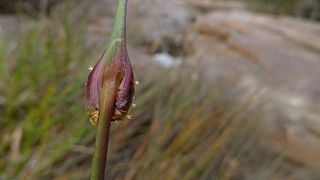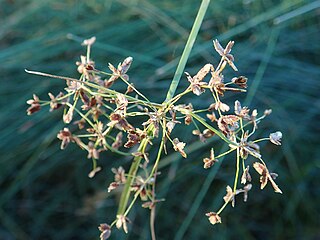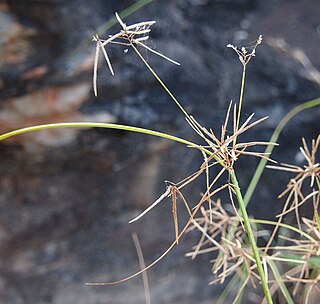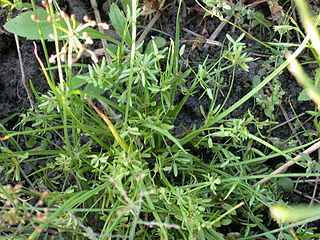
Cyperus bulbosus is a species of sedge found across Africa, the Middle East, Indian subcontinent, Southeast Asia, and Australia. In Australia, it is commonly called Nalgoo or (Australian) bush onion or "wild onion", but is not related to the onion or other Alliaceae. It is a component of Australian bushfood, but is considered an agricultural weed in other areas.

Cyperus polystachyos, also known as Pycreus polystachyos, and also called manyspike flatsedge in the US, or bunchy sedge, coast flatsedge, many-spiked sedge or Texas sedge in Australia, is a herbaceous species in the family Cyperaceae, widespread in tropical and subtropical areas around the world, sometimes extending its range into temperate regions.

Cyperus squarrosus is a species of sedge known by several common names, including bearded flatsedge and awned flatsedge. It is found in wet environments in North and South America, Africa, Australia, southern Asia and Italy.

Carex pumila, commonly known as strand sedge or spreading sedge, is a species of sedge of the family Cyperaceae.

Chorizandra cymbaria, commonly known as heron bristle rush or heron bristle sedge, is a sedge of the family Cyperaceae that is native to Australia.
Cyperus alterniflorus is a sedge of the family Cyperaceae that is native to Australia.

Cyperus betchei is a sedge of the family Cyperaceae that is native to Australia.

Cyperus concinnus is a sedge of the family Cyperaceae that is native to Australia, and found in New South Wales, Queensland, the Northern Territory, South Australia, Victoria and Western Australia.

Cyperus dactylotes is a sedge of the family Cyperaceae that is native to all of mainland Australia except for Victoria.

Cyperus flaccidus is a sedge of the family Cyperaceae that is native to Australia.

Cyperus gilesii, commonly known as Giles' flat-sedge, is a sedge of the Cyperaceae that is native to Australia.

Cyperus javanicus, also known as the Javanese flatsedge, is a sedge of the family Cyperaceae that is native to Indonesia and Australia.
Cyperus nutans is a sedge of the family Cyperaceae that is native to Australia, China, India, Bangladesh, south-east Asia, Malaysia, India, and Indonesia.
Cyperus rigidellus is a sedge of the family Cyperaceae that is native to Australia.

Cyperus vaginatus, commonly known as stiff-leaf sedge or stiff flat-sedge, is a sedge of the family Cyperaceae that is native to Australia.
Cyperus victoriensis, also known as channel nut grass is a sedge of the family Cyperaceae that is native to all the states and territories of mainland Australia.
Cyperus viscidulus is a sedge of the family Cyperaceae that is native to north western Australia.
Cyperus vorsteri is a sedge of the family Cyperaceae native to KwaZulu-Natal in South Africa.
Cyperus zollingeri, commonly known as roadside flatsedge, is a sedge of the family Cyperaceae that is native to tropical areas of Australia, Africa and Asia.
Eleocharis acuta, commonly known as common spikerush or small spikerush, is a sedge of the family Cyperaceae that is native to Australia.














